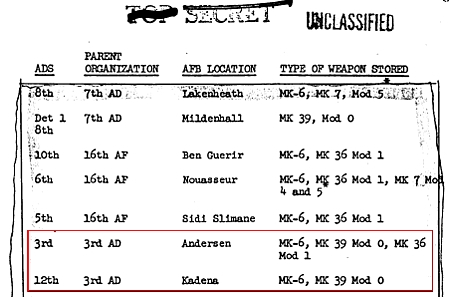.
By Hans M. Kristensen
Thanks to the efforts of Bill Burr at the National Security Archive, some of the veil covering U.S. nuclear war planning against China in the 1958 Taiwan Strait crisis now has been lifted by a declassified military study.
It shows that on the day after the Chinese began shelling the Quemoy islands on August 23, 1958, U.S. Air Force Headquarters apparently assured Pacific Air Forces “that, assuming presidential approval, any Communist assault upon the offshore islands would trigger immediate nuclear retaliation.” Yet President Dwight D. Eisenhower fortunately rejected the use of nuclear weapons immediately, even if China invaded the islands, and emphasized that under no circumstances would these weapons be used without his approval.
Caution against nuclear use didn’t mean not planning for it, however, and in the years after the Taiwan Strait crisis an enormous nuclear build-up occurred in the Far East. The numbers started to decline in the 1970s, and for a period during the 1980s and first half of the 1990s, nuclear planning against China was reduced to reserve force contingencies. In the past decade, however, China has again become a focus for U.S. nuclear strike planning.
The Available Nuclear Bombs
Shortly after the Chinese shelling of Quemoy began, General Nathan Twining, the Chairman of the Joint Chiefs of Staff, explained during a meeting with President Eisenhower’s cabinet that U.S. aircraft at the outset would drop 10-15 kilotons nuclear bombs on selected fields in the vicinity of Amoy (Xiamen). The Pacific Air Forces drew up a contingency plan based on the assumption that the United States would carry out the nuclear strikes necessary to defeat the attacking Chinese forces.
At that time, the Matador nuclear cruise missile was already deployed in Taiwan. The missile could deliver a 20 kt W5 warhead to a range of about 965 km (600 miles). From Taiwan, the Matador could potentially have hit Chinese troop concentrations around Amoy, but General Twining apparently favored bombs. Nuclear bombs, however, did not arrive in Taiwan until January 1960, but a declassified document previously released to me under FOIA shows they were available on Guam and Okinawa. The bombs included three types – Mk-6 (only Guam), Mk-36 Mod 1, and Mk-39 Mod 0 – with yields ranging from 8 kilotons to 10 megatons (see Table 1).
| Table 1: Nuclear Bombs Deployed Near Taiwan, June 1958 |
|||
| Base | Bomb Type | Yield(s) | Custodian Unit |
| Anderson AFB, Guam |
Mk-6 Mk-36 Mod 1 Mk-39 Mod 0 |
8, 22, 61, 160 kt 10,000 kt ~3,750 kt |
3 ADS |
| Kadena AB, Okinawa | Mk-6 Mk-39 Mod 0 |
8, 22, 61, 160 kt ~3,750 kt |
12 ADS |
| Sources: U.S. Strategic Air Command, History of the Strategic Air Command 1 January 1958 – 30 June 1958, Historical Study Number 73, Volume 1, n.d. [1959] p. 89. Document obtained under FOIA; Chuck Hansen, Swords of Armageddon, Version 2, 2002. (Table corrected October 21, 2008) |
|||
.
The Mk-6 was a tactical bomb that could be delivered in a ground or airburst mode by a variety of Air Force and Navy aircraft and probably would have been the weapon of choice for the Taiwan scenario. The Mk-36 and Mk-39 were both strategic megaton weapons more suited for use against large area targets such as cities or to “dig up” underground facilities.
In mid-August, five Strategic Air Command B-47 bombers on Guam were put on alert to conduct nuclear strikes against airfields on the Chinese mainland if necessary. Such attacks would be necessary, General Twining said, if initial nuclear strikes against troop concentrations failed to cause China to lift their blockade of Quemoy.
|
Figure 1: |
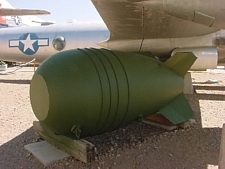  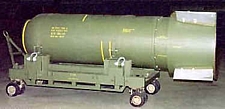 |
|
At the time of the 1958 Taiwan Strait crisis, US Strategic Air Command deployed Mk-6, Mk-36 and Mk-39 (top down) nuclear bombs on Guam and Okinawa (only Mk-36 and 39). |
The Nuclear Posture After The Taiwan Crisis
Fortunately the general didn’t have his way and the declassified study obtained by Burr concludes that the “principal question” raised by the crisis was: “Would the American military in future crises encounter cautious presidential control over nuclear weapons?” Fortunately it did, but although this reality caused the military to focus more on non-nuclear warfare, it did little to stem the forward deployment of large numbers of nuclear weapons to Northeast Asia at the time.
In South Korea, a few months before the Taiwan Strait crisis erupted, deployment of six U.S. nuclear weapon systems was already underway: the Honest John surface-to-surface missile; the Matador cruise missile; the Atomic-Demolition Munition (ADM) nuclear landmine; the 280-mm gun; the 8-inch (203mm) howitzer; and nuclear bombs for fighter bombers. After the Taiwan Strait crisis cooled down, five more nuclear weapon systems arrived in South Korea: the surface-to-surface missile systems Lacrosse, Davy Crockett, and Sergeant; the dual-mission Nike Hercules anti-air and surface-to-surface missile; and finally the 155-mm Howitzer. At the peak of the build-up in 1967, nearly 950 warheads were deployed in South Korea.
Nuclear weapons also were deployed to Taiwan. As mentioned above, the Matador cruise missile was already present on the island when the Taiwan Strait crisis erupted. The nuclear bombs arrived in January 1960 and stayed for a decade and a half until July 1974. Together with nuclear bombs for tactical fighter wings deployed at Clark Air Base in the Philippines, Kusan Air Base in South Korea and Kadena Air Base on Okinawa, the nuclear bombs in Taiwan probably were intended for use against targets in China and North Korea.
The deployment to Taiwan was not without its problems: After a series of inspections of nuclear weapons facilities in the Far East, the U.S. Senate Foreign Relations Committee in 1970 sharply criticized the U.S. policy that guided the forward deployment as well as the agreements and understandings with the host country about the deployment, use, or withdrawal of these weapons. “One example: …the ranking United States Army officer in [Taiwan] testified he was not aware whether or not nuclear weapons were located on Taiwan.”
After the weapons were withdrawn from Taiwan in July 1974, the three other fighter wings in the Philippines, Okinawa and South Korea continued to be tasked under the SIOP (Single Integrated Operational Plan), the latter as a Quick Reaction Alert strike force. At that time the SIOP included four major attack options, two of which were against China, and three of 11 new Selected Attack Options directed by NUWEP-74 aimed at virtually all elements of Chinese military and industrial facilities.
In 1982, however, China was removed from SIOP planning to reflect the country’s new status as a U.S. partner against the Soviet Union. During this time, nuclear planning against China was confined to a small number of contingency options involving the strategic reserve force and non-strategic nuclear weapons. The Joint Strategic Capabilities Plan (JSCP) for Fiscal Year 1984, for example, did order the preparation of a Contingency Plan (CONPLAN) for the employment of nuclear weapons against China’s power projection capabilities (presumably ballistic missile and air bases). But this requirement was short lived and was dropped again in the FY85 JSCP.
Taiwan and China in Recent Nuclear Planning
Sixty years after the shelling of Quemoy islands, China and the Taiwan Strait remain a center for U.S. military planning and a potential trigger for a nuclear conflict between the United States and China. But with the glossy Soviet Military Power from the 1980s replaced by Military Power of the People’s Republic of China as the Pentagon’s most prominent unclassified annual threat report – and most U.S. ballistic missile submarines now patrolling in the Pacific instead of in the Atlantic as during the Cold War, and bomber squadrons periodically forward-deploying to Guam – China appears to have taken center stage.
The rise of China in recent U.S. nuclear planning occurred gradually in the 1990s after the Soviet Union fell apart and the Cold War faded. Coinciding with U.S. intelligence reports about China’s slow but steady modernization of long-range strategic nuclear forces, some military planners began arguing that it was necessary to begin to target China on a more ongoing and fundamental basis.
During the 1994 Nuclear Posture Review, STRATCOM and some DOD officials unsuccessfully lobbied for increasing nuclear planning against China. One example of this effort was STRATCOM’s Sun City Extended nuclear force structure study from 1994, which – unlike the Sun City study completed a year earlier – dedicated more than a dozen pages to analyzing China scenarios. It identified two: a US/North Korea/China excursion involving less than a full-scale attack against China; and a US/China confrontation involving a major-attack response plan (see Figure 2).
|
Figure 2: |
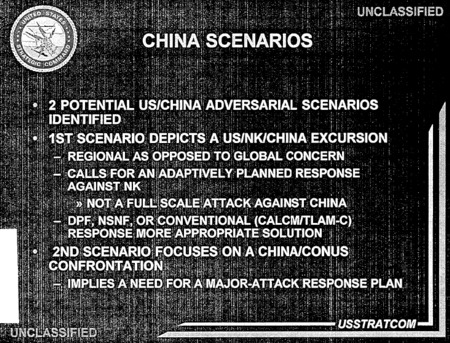 |
| A 1994 STRATCOM nuclear force structure study identified two China scenarios: one involving North Korea; and a direct US-China confrontation most likely over Taiwan. Document obtained under FOIA. |
.
Although advocates for a stronger focus on China failed to change policy in 1994, a new Taiwan Strait crisis in March 1996 provided new impetus after China test launched several short-range ballistic missiles from the mainland into the waters north and south of Taiwan (the northern impact area being only 19 miles from Chilung). The exercise was the latest and largest in a series of what U.S. Naval Intelligence considered to be rehearsals of a contingency scenario for the invasion of Taiwan, a new scenario first detected in 1994. The United States responded by sending two aircraft carrier battle groups to the area.
The following year, in October 1997, President Clinton signed Presidential Decision Directive (PDD)-60, which lowered the targeting requirement against Russia but reportedly at the same time broadened the spectrum of Chinese facilities that could be attacked with nuclear weapons to include the country’s growing military-industrial complex and improved conventional forces. Despite the implications, one official told Washington Post, there was “no debate with respect to the targeting of China.”
The language of PDD-60 was specific enough to allow STRATCOM to formally bring China back into SIOP planning after a hiatus of 16 years. A classified STRATCOM study from 1999 labeled China as “a growing force,” and one of STRATCOM’s first acts was to build the CHISOP, the Chinese Integrated Strategic Operations Plan, to “war game” that force against U.S. nuclear forces. CHISOP was similar to the RISOP (Red Integrated Strategic Operations Plan), a hypothetical Russian war plan that had existed for many years. But whereas China in RISOP was “war gamed” as part of the “blue force” against the Soviet Union and Russia, one effect of PDD-60 was that China in the planning became an independent “red force.” The CHISOP was intended to serve as a “single-point estimate” of Chinese strategic capabilities and potential employment by using available intelligence information about Chinese nuclear weapon systems, strategy, and policy in “war games” to assess the effectiveness of U.S. nuclear strike plans against China.
|
Figure 3: |
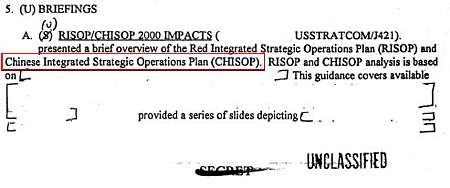 |
| Following President Clinton’s signing of PDD-60 in October 1997, which reportedly authorized a broadening of nuclear targeting against China, STRATCOM began designing CHISOP, the Chinese Integrated Strategic Operations Plan, a parallel to the RISOP (Russian Integrated Strategic Operations Plan) previously used to “war game” U.S. and Russian nuclear forces. Document obtained under FOIA. |
.
It was around this time that the Bush administration’s Nuclear Posture Review in late 2001 identified a military confrontation over the status of Taiwan as an “immediate contingency” influencing the sizing U.S. nuclear forces. China, due to its still evolving strategic objectives and ongoing modernization of nuclear and non nuclear forces, was described as a country that “could be involved in an immediate or potential contingency.”
Yet CHISOP appears to have been short lived, at least with that name. In early 2005, RISOP was canceled and with it, presumably, the efforts to build the CHISOP. The cancellation probably reflected a change in U.S. strategic war planning of which only little is known, coinciding with the publication of a new Nuclear Weapons Employment Policy (NUWEP) document in 2004 and a major revamping of the U.S. strategic nuclear war plan in October 2004 (OPLAN 8044 Revision 05). CHISOP and RISOP were probably incompatible with modern planning because they were products of the Soviet-focused planning for the SIOP, which has since been converted into a “family of plans applicable in a wider range of scenarios” with “more flexible options” against potential “adversaries in a wider range of contingencies.”
CHISOP or not, however, the March 2006 Quadrennial Defense Review underscored the central status of China in U.S. planning: “Of the major and emerging powers, China has the greatest potential to compete militarily with the United States” as it “continues to invest heavily in its military, particularly in its strategic arsenal and capabilities designed to improve its ability to project power beyond its borders.”
Additional information: Chinese Nuclear Forces and U.S. Strategic Nuclear War Planning | White House Guidance Led to New Nuclear Strike Plans Against Proliferators, Document Shows
While it is reasonable for governments to keep the most sensitive aspects of nuclear policies secret, the rights of their citizens to have access to general knowledge about these issues is equally valid so they may know about the consequences to themselves and their country.
Nearly one year after the Pentagon certified the Sentinel intercontinental ballistic missile program to continue after it incurred critical cost and schedule overruns, the new nuclear missile could once again be in trouble.
“The era of reductions in the number of nuclear weapons in the world, which had lasted since the end of the cold war, is coming to an end”
Without information, without factual information, you can’t act. You can’t relate to the world you live in. And so it’s super important for us to be able to monitor what’s happening around the world, analyze the material, and translate it into something that different audiences can understand.
